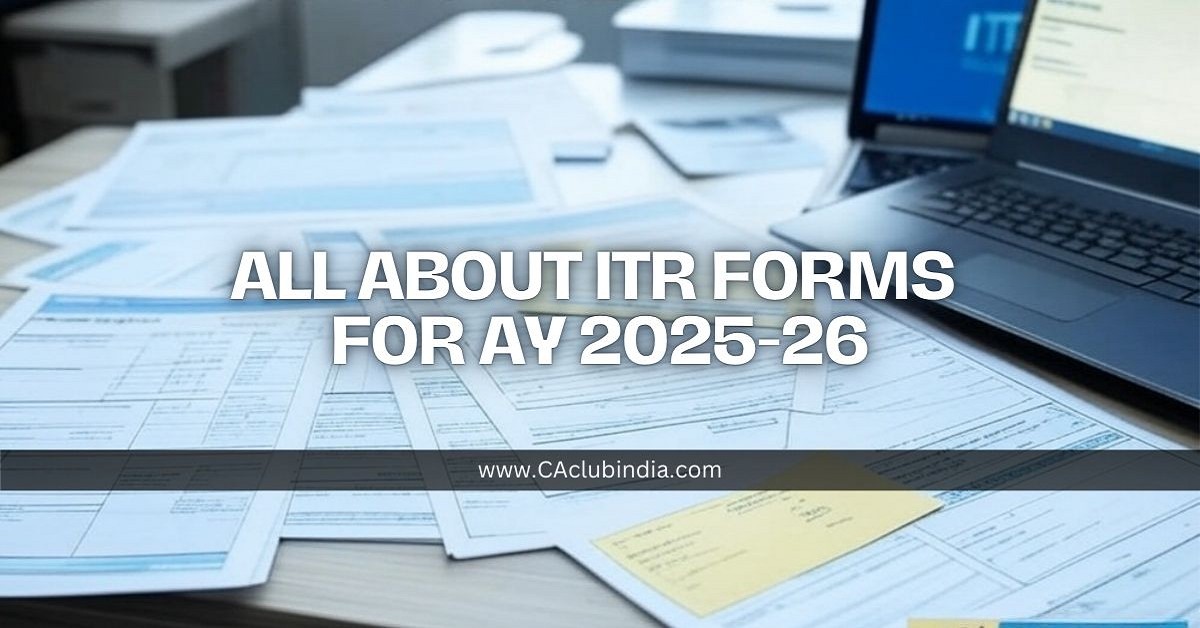It's an important step in managing your finances, staying tax-compliant, and planning your future. One of the most common queries during the tax season is: "Which ITR form should I file?"
The Income Tax Department of India has notified seven different ITR forms for Assessment Year (AY) 2025-26, applicable to various categories of taxpayers based on their income type, source, and residential status.
Let's break down each form in detail - along with the due date for filing - to help you make the right choice.

Due Date for Filing ITR for AY 2025-26
|
Category of Taxpayer |
Due Date to File ITR |
|
Individuals / HUF / Firms (non-audit cases) |
31st July 2025 |
|
Businesses requiring audit |
31st October 2025 |
|
Assessees required to furnish report under Section 92E (Transfer Pricing) |
30th November 2025 |
List of ITR Forms and Their Applicability
1. ITR-1 (Sahaj)
Applicable To:
- Resident Individuals (Ordinary Residents only)
- Total income up to ₹50 lakh
- Income from:
- Salary or Pension
- One house property
- Other sources (excluding winnings from lottery, racehorses, etc.)
Not Applicable If:
- You are a Director in a company
- You have foreign assets or foreign income
- You have capital gains
- You have more than one house property
- Agricultural income exceeds ₹5,000
2. ITR-2
Applicable To:
- Individuals and Hindu Undivided Families (HUFs)
- Who do not have income from business or profession
Includes Income From:
- Salary / Pension
- Multiple house properties
- Capital gains
- Foreign assets/income
- Dividend income
- Agriculture income over ₹5,000
Not For:
- Business or professional income
3. ITR-3
Applicable To:
- Individuals and HUFs having income from business or profession
Also Includes:
- Salary, house property, capital gains, and other sources
- Income as a partner in a firm
Who Should Use It:
- Business owners
- Freelancers
- Professionals like doctors, engineers, consultants
4. ITR-4 (Sugam)
Applicable To:
- Individuals, HUFs, and Firms (excluding LLPs)
- With total income up to ₹50 lakh
- Income under presumptive taxation (Sections 44AD, 44ADA, or 44AE)
Suitable For:
- Small businesses
- Freelancers and professionals (using presumptive income scheme)
Not For:
- Income from capital gains or foreign assets
- Directors in a company
- Those with more than one house property
5. ITR-5
Applicable To:
- Partnership Firms (including LLPs), AOPs, BOIs, Estate of deceased, etc.
- Who do not file ITR-7
Covers:
- Firms and entities other than individuals or companies
6. ITR-6
Applicable To:
- Companies (except those claiming exemption under Section 11 for charitable/religious purposes)
Must Be Filed:
- Electronically with Digital Signature Certificate (DSC)
7. ITR-7
Applicable To:
- Persons including companies required to furnish return under Sections 139(4A) to 139(4D)
- Charitable/religious trusts
- Political parties
- Research institutions
- Educational institutions
Important Points to Remember
- Choosing the wrong form may lead to rejection or notice from the IT Department.
- Income source, residential status, income level, and type of entity determine the correct ITR form.
- Filing before the due date helps avoid penalties and interest on tax dues.
Summary
Understanding which ITR form is applicable based on your income profile is the first and most crucial step towards a smooth and compliant tax filing process. Whether you're a salaried employee, freelancer, business owner, or part of a charitable trust - the Income Tax Department has a designated ITR form for your case.





 CAclubindia
CAclubindia

